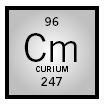Curium

MELTING POINT:
1,340°C
BOILING POINT
: 3,110°C
DENSITY
: 13.5 g/cm
3
MOST COMMON IONS
: Cm
3+
The element curium was discovered in 1944 by Glenn T. Seaborg, Ralph A. James, and Albert Ghiorso at the University of California at Berkeley. Its discovery was a result of the bombardment of plutonium-239 ( 239 Pu) with helium ions. Curium was named after the Nobel laureates Pierre and Marie Curie, who were pioneers in the discovery of radioactivity. Although curium is synthetic, minute traces of this element may exist in natural uranium deposits. Curium has ten known isotopes , all of which are radioactive. The longest-lived is 247 Cm, which has a half-life of 16 million years. Although curium has little use outside of research, 242 Cm (half-life 163 days) has been used in isotopic power generators, as it produces about 3 watts of heat energy per gram due to its radioactive decay . Curium-245 ( 245 Cm, half-life 8,500 years) is fissionable , and can be used as nuclear reactor fuel enrichment. Curium was also the α -particle source for the Alpha Proton X-ray Spectometer. The physical properties of curium include a boiling point of 1,340°C (2,444°F), and a melting point of 3,110°C (5,630°F). Its density is 13.5 g/cm 3 . Curium is very reactive with oxygen, steam, and acids (but not with bases). Several oxides and halides of this element have been prepared. Curium has no known biological uses. If ingested, it tends to accumulate in bone marrow, where it is highly dangerous because its high intensity of radioactivity destroys red blood cells.
SEE ALSO Actinides ; Actinium ; Americium ; Berkelium ; Californium ; Curie, Marie Sklodowska ; Einsteinium ; Fermium ; Mendelevium ; Neptunium ; Nobelium ; Plutonium ; Protactinium ; Thorium ; Uranium .
Carolyn J. Anderson
Bibliography
Guilmette, R. A., and Mewhinney, J. A. (1989). "A Biokinetic Model of Inhaled Cm Compounds in Dogs: Application to Human Exposure Data." Health Physics 57(1):187–197.
Higgins, G. H., and Crane, W. W. T. (1958). "Production and Chemical Isolation of Curium in Thousand-Curie Quantities." In International Conference on the Peaceful Uses of Atomic Energy , 2nd edition. Vol. 17, Processing Irradiated Fuels and Radioactive Materials. Geneva, Switzerland: United Nations.
Internet Resources
Information available from http://www.chemicalelements.com/elements/cm.html .